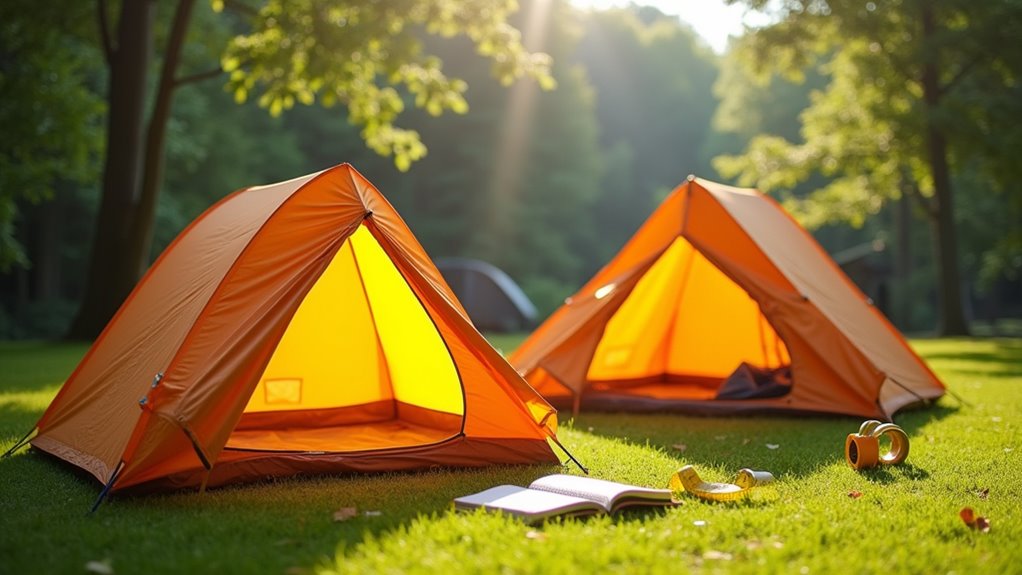How To Find Surface Area Of A Tent
This post contains affiliate links. As an Amazon Associate, we earn from qualifying purchases.
To find the surface area of a tent, measure its length, width, and height, then use the appropriate formula based on its shape. For example, cone-shaped tents require calculating the curved surface area plus the base area using CSA = π × r × l + π × r². Further details and formulas for other tent shapes will be explained later in this article to help you refine your calculations and improve accuracy.
Essential Facts in 30 Seconds
- Determine the tent shape to select the correct surface area formula.
- Measure the tent’s base length, width, and height precisely.
- Use CSA = π × r × l + π × r² for cone-shaped tents.
- Use SA = 2 × (l × s) + s² for pyramid-shaped tents.
- Add areas of basic shapes to find total surface area for irregular tents.
Understanding Tent Shapes and Their Geometric Models

Each tent shape has its own strengths and weaknesses.
Dome tents use a design that maximizes inside space while using less material. This means they resist bad weather well and stay strong.
Pyramid tents use one central pole to hold up the tent.
A-frame tents stand on two poles, making a simple triangle shape.
Geodesic dome tents use many poles crossing each other. These poles form triangles that make the tent very strong.
Tunnel tents offer a long, roomy space but need more material to build.
Knowing these shapes helps you pick a tent that fits your needs.
Think about what matters most: space, strength, or weight. The right choice makes your camping trip easier and more fun. Additionally, selecting a tent with robust frame construction can enhance its durability in harsh conditions.
Measuring Tent Dimensions Accurately
Measure your tent carefully for the best fit and comfort. Use a steel tape to check the length and width of the tent’s base. A laser distance meter works well to find the tent’s height quickly and accurately. Write down the inside measurements. These show how much space you really have inside. Mark the start and end points on the fabric or frame using chalk.
For tents with odd shapes, take measurements from several spots. This helps you get exact numbers. In tents with many rooms, measure each room by itself. Measure twice or more to be sure. Before pitching the tent, ensure you have a flat, clear area for accurate measurements.
Check your numbers against the tent’s manual or label. Always measure the tent on flat ground and after it’s fully set up. This gives the true size of your tent. Following proper tent assembly steps ensures accurate measurements and prevents miscalculations. Follow these simple steps for clear and exact tent sizes.
Calculating Surface Area for Different Tent Types

Calculating the surface area of tents helps know how much fabric you need. Different tents have different shapes. Each shape uses a special formula to find the surface area.
Here are some common tent types and their formulas:
| Tent Type | Shape | Surface Area Formula |
|---|---|---|
| Cone-shaped Tent | Cone | CSA = π × r × l + π × r² |
| Square-based Pyramid | Pyramid | SA = 2 × (l × s) + s² |
| Triangular Prism Tent | Prism | SA = (b × h) + l × P |
| Cylindrical Tent | Cylinder | A = 2 × π × r × h + π × r² |
| Irregular Tent | Composite | Add areas of basic shapes |
Here, r means radius, l means slant height, s means side length, b means base, h means height, and P means perimeter.
Knowing these formulas saves fabric and money. Use them to plan your tent well. Simple math makes big tasks easier.
Practical Applications of Tent Surface Area
Knowing tent surface area helps you camp smarter. It makes your tent work better and saves you money. Here are three important uses:
- Save Fabric: Calculating surface area stops fabric waste. You buy just the right amount. This saves money and helps the planet.
- Stay Warm and Fresh: Surface area affects heat and air flow. A good design keeps you warm and stops wet walls. It makes your tent cozy.
- Carry Light: Smaller surface means lighter tents. Easy to pack and carry. Perfect for hikers who want light gear but enough space. Understanding tent dimensions is essential for accurate surface area calculations.
Tips for Accurate Surface Area Calculations

Calculating your tent’s surface area can be simple with the right steps. Use a tape measure or laser meter to get exact numbers. Measure the base length, width, height, and slant height carefully. Take each measurement twice to avoid mistakes.
Know your tent’s shape—cone, pyramid, or prism—because each needs a different formula.
Use the correct math for each shape. For example, find the curved surface area of a cone with the formula CSA = π × r × l. Draw your tent and mark all measurements clearly. This helps you see the parts and avoid errors.
Check your answers by comparing them to the tent’s label or instructions. This way, you’ll know if you need more fabric or not. Following these steps saves time and gives you confidence in your calculations.
Frequently Asked Questions
Can I Use a Tent’s Surface Area for Energy Efficiency Calculations?
Using a tent’s surface area helps measure energy efficiency clearly. It shows how much heat can escape through the tent walls. Knowing this helps pick better materials that keep warmth inside. A tent with good insulation reduces energy needed for heating. This saves fuel and money during camping or outdoor stays. Surface area plays a big role in heat loss and thermal comfort. Simple math with surface area guides smart energy planning for tents.
How Does Tent Material Affect Surface Area Measurements?
Tent fabrics change size with tension and wetness. Nylon stretches easily. Dyneema stays tight and firm. This shift changes how much surface area you see. Each fabric affects your measurements in its own way. Keep fabric type in mind for accurate results.
What Tools Are Best for Measuring Tent Dimensions?
Use tools like measuring tape, laser distance measurer, or measuring wheel to measure tents. These tools give quick and accurate results. Measuring tape works well for small tents. Laser measurers cover long distances fast. Measuring wheels help measure around large tents easily. Combine tools with careful measuring steps for best results. This way, you get precise tent dimensions every time.
Is There a Difference Between Interior and Exterior Surface Area?
Interior surface area means the space you can actually use inside a room or object. Exterior surface area covers all outer parts, including walls, edges, and seams. Knowing both helps you buy the right amount of paint or materials. It also shows how well a space keeps heat or stays strong. For example, a house with a large exterior surface loses more heat. This affects your comfort and energy bills. Understanding these differences saves money and makes projects easier.
How Do Weather Conditions Impact Tent Surface Area Calculations?
Weather conditions change how you calculate your tent’s surface area. Strong winds push against the tent, so add extra space to handle the force. Snow can pile up on the roof, making it heavier. Increase the area to support this weight safely. Rain adds moisture and weight too, requiring a larger area to keep the tent stable. These changes keep your tent strong and safe during bad weather. Always measure with these factors in mind to avoid damage.
Conclusion
Knowing how to find the surface area of a tent helps in many ways. It guides you to pick the right tarp size. It also ensures good airflow inside the tent. A typical camping tent covers about 100 square feet. This space fits several people comfortably. Use simple math formulas to measure the area. Measure the tent’s length, width, and height carefully. Apply the correct calculations for each part. This way, you get an accurate surface area. This knowledge makes your outdoor trips easier and more fun.
